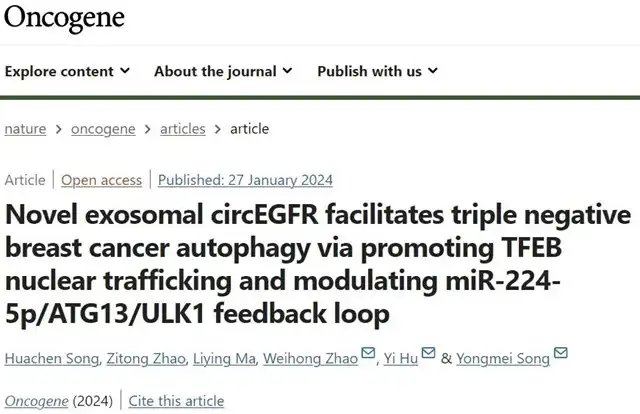Exosomal circEGFR: A Therapeutic Target in Triple Negative Breast Cancer
- Normal Liver Cells Found to Promote Cancer Metastasis to the Liver
- Nearly 80% Complete Remission: Breakthrough in ADC Anti-Tumor Treatment
- Vaccination Against Common Diseases May Prevent Dementia!
- New Alzheimer’s Disease (AD) Diagnosis and Staging Criteria
- Breakthrough in Alzheimer’s Disease: New Nasal Spray Halts Cognitive Decline by Targeting Toxic Protein
- Can the Tap Water at the Paris Olympics be Drunk Directly?
Exosomal circEGFR: A Therapeutic Target in Triple Negative Breast Cancer
- Should China be held legally responsible for the US’s $18 trillion COVID losses?
- CT Radiation Exposure Linked to Blood Cancer in Children and Adolescents
- FDA has mandated a top-level black box warning for all marketed CAR-T therapies
- Can people with high blood pressure eat peanuts?
- What is the difference between dopamine and dobutamine?
- How long can the patient live after heart stent surgery?
Exosomal circEGFR: A Therapeutic Target in Triple Negative Breast Cancer
Triple-negative breast cancer (TNBC) cells are in a state of lower oxygen and nutrient deprivation compared to non-TNBC cells, which leads to consistently higher levels of autophagy in TNBC cells.
Increasing evidence suggests that circular RNAs (circRNAs) are involved in the development and progression of tumors. However, the regulation and function of autophagy-induced circRNAs in TNBC are not yet clear.
Recently, researchers from the Chinese Academy of Medical Sciences published a study titled “Novel exosomal circEGFR facilitates triple negative breast cancer autophagy via promoting TFEB nuclear trafficking and modulating miR-224-5p/ATG13/ULK1 feedback loop” in the journal Oncogene.
The researchers identified circRNA candidate molecules involved in autophagic responses in TNBC cells under amino acid starvation conditions through RNA sequencing.
The results showed that circEGFR was significantly upregulated in autophagic cells. Knocking down circEGFR inhibited autophagy in TNBC cells, and exosome-derived circEGFR induced autophagy in recipient cells in the tumor microenvironment.
In vitro and in vivo functional analysis confirmed that circEGFR is an oncogenic circRNA in TNBC.
Overall, this study suggests that circEGFR plays a key role in autophagy, malignant progression, and metastasis in TNBC. circEGFR could be a potential diagnostic biomarker and therapeutic target for TNBC.

https://www.nature.com/articles/s41388-024-02950-4
Research Background:
Breast cancer is the most common and highly heterogeneous tumor among women globally. The expression of estrogen receptor (ER), progesterone receptor (PR), and ERBB2 receptor (HER2) divides breast cancer into at least four subtypes (Luminal A, Luminal B, HER2-enriched, triple-negative), laying the foundation for breast cancer classification. TNBC patients have shorter survival times than other subtype breast cancer patients, with a 40% mortality rate within 5 years of diagnosis. Approximately 46% of TNBC patients develop distant metastases, indicating its high invasiveness. Due to its unique molecular phenotype, TNBC is insensitive to endocrine or molecular targeted therapy. Therefore, finding new targets and treatment strategies is an urgent issue.
Circular RNA is a form of covalently closed circular RNA. Studies have shown that circRNAs are abnormally expressed in breast cancer and participate in various biological processes such as proliferation, metastasis, and chemotherapy resistance of breast cancer. circRNAs provide a new perspective for the diagnosis and treatment of breast cancer.
Research Progress:
The expression of circEGFR in breast cancer tissue is higher than that in paired adjacent tissues. Although there is no significant difference in the expression of circEGFR between tumor tissues of HER2 and Luminal subtypes compared with adjacent tissues, there is an increasing trend. Compared with paired adjacent tissues, the expression of circEGFR in tumor tissues of TNBC patients is significantly overexpressed. The expression of CircEGFR is upregulated in TNBC tissues compared with HER2-enriched and Luminal tissues. The expression of CircEGFR in tissues with lymph node metastasis is higher than that in tissues without lymph node metastasis. These data suggest that CircEGFR is a primarily cytoplasmic stable circRNA that participates in autophagy processes while exerting an oncogenic effect to promote TNBC progression.
To study the functional loss effect of circEGFR in vivo, researchers constructed stable CAL-51 cells with knocked-down circEGFR (sh-circEGFR) and negative control cells (sh-NC). Tumor cells were implanted subcutaneously into BALB/c nude mice mammary fat pads. After 10 weeks, the mice were euthanized, and tumor tissues were isolated. Researchers found that downregulation of circEGFR inhibited the size and weight of tumors. qPCR results showed significantly reduced expression of circEGFR in sh-circEGFR tumors. Immunoblotting results showed decreased expression of LC3II in sh-circEGFR xenografts. Immunohistochemistry results showed decreased expression of Ki67 in sh-circEGFR tumors compared with the control group. The study results indicate that knocking down circEGFR can reduce the rate of lung metastasis in mice. These data suggest that circEGFR promotes TNBC progression in vivo.
Research Conclusion:
The results of this study provide new insights into the regulatory mechanism of circEGFR-mediated autophagy in accelerating TNBC progression, indicating that exosomal circEGFR is a promising biomarker and target for TNBC therapy.
Exosomal circEGFR: A Therapeutic Target in Triple Negative Breast Cancer
References:
https://www.nature.com/articles/s41388-024-02950-4
(source:internet, reference only)
Disclaimer of medicaltrend.org
Important Note: The information provided is for informational purposes only and should not be considered as medical advice.



